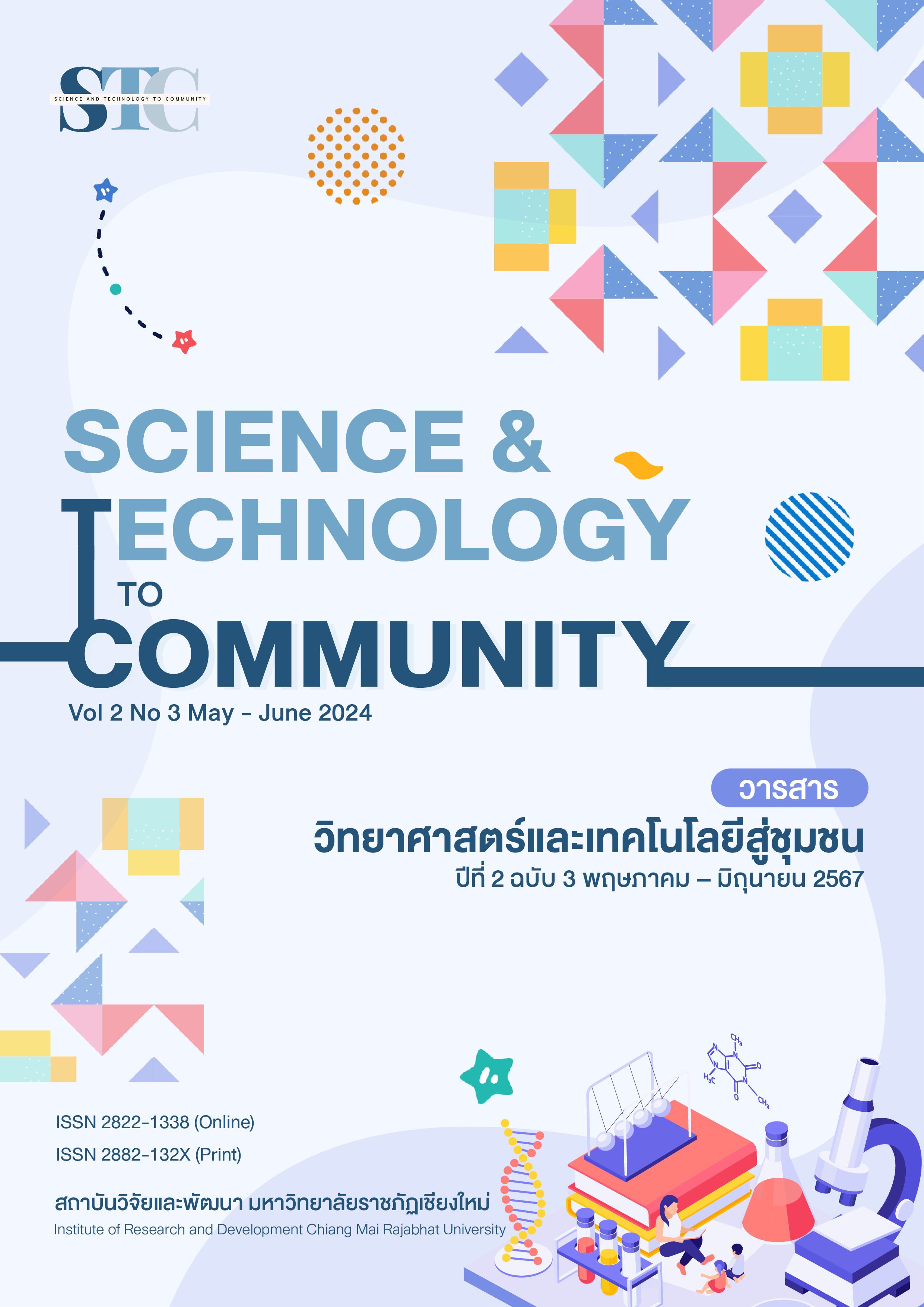An Application of the Management of Agrochemical Packaging Waste Promoting Program of Farmer Households, Han Kaeo Sub-district, Hang Dong District, Chiang Mai Province
DOI:
https://doi.org/10.57260/stc.2024.768Keywords:
Promoting program, Agrochemical packaging waste management, Households, FarmerAbstract
In Thailand, agrochemicals are used by farmers to increase crop quality and agricultural product production. This leads to the rising of agrochemical container waste, which is hazardous waste and need to be disposed of properly. This quasi-experimental one-group pretest-posttest study aimed to determine the effectiveness of the program for promoting household agrochemical packaging waste management among farmers in Han Kaeo Subdistrict, Hang Dong District, Chiang Mai Province. The participants of the study were 34 farmers who lived in Han Kaeo Subdistrict by convenience sampling method. The intervention in this study was the program for promoting household agrochemical packaging waste management and the data collection instruments were the questionnaires. The demographic data were statistically analyzed using descriptive statistics. Pre- and post-scores of knowledges were compared using the Wilcoxon signed rank test, while the scores of self-efficacy and practices were compared using the paired T-test.
The result shows that most of the samples are males (67.65%), average age is 65.29 years old, most of the samples graduated from primary school (73.50%), have average monthly income 3,020.59 baht, the average duration of working as farmer is 26.79 years and do farming by themselves (91.18%), have an agricultural area of 5–10 rai (52.94%), most of them do horticulture farming (73.50%), average yearly income is 40,176.47 baht, and average expenses for agrochemicals is 8,126.47 baht. A knowledge source about managing agrochemical container waste is a government officer (45.16%). The data of the agrochemical used and agrochemical packaging waste management show that most of sample have bought agrochemical from agrochemical store (62.00%), insecticide is the most used in past year (36.26%), the sample used agrochemical 5-10 liter per year (50.00%), plastic bottles packaging waste occurs the most (53.22%), farmers managed agrochemical packaging waste by selling them to recycled waste buyer (38.10%) and disposed agrochemical packaging waste 1-2 time per year (79.41%). The result shows the mean scores of knowledge, self-efficacy and practices toward agrochemical container waste management among farmers before administering the program are 9.85, 4.48, and 2.43, respectively. The mean scores of knowledge, self-efficacy, and practices after providing the program were 10.88, 4.65, and 2.70, respectively. The mean scores of knowledges after the program were significantly higher than those before the program (p=0.006). The mean scores of self-efficacy after the program were significantly higher than those before the program (p<0.001). The mean scores of practices after the program were significantly higher than those before the program (p<0.001). The findings of this study can contribute to the development of strategies aimed at promoting proper management of agrichemical packaging waste. By raising awareness among farmers, sustainable improvements in their behaviors can be achieved.
Downloads
References
กรมควบคุมมลพิษ. (2563). (ร่าง) Roadmap การจัดการขยะพลาสติก พ.ศ. 2561 – 2573. สืบค้นจากhttps://www.pcd.go.th/wp-content/uploads/2020/05/pcdnew-2020-05-27_06-47-53_174751.pdf
กรมควบคุมมลพิษ. (2565). รายงานสถานการณ์ของเสียอันตรายจากชุมชน ปี พ.ศ. 2565. สืบค้นจากhttps://www.pcd.go.th/publication/29745
กรมส่งเสริมการเกษตร. (2564). ระบบฐานข้อมูลทะเบียนเกษตรกรกลาง. สืบค้นจาก http://www.farmer.doae.go.th
กองสิ่งแวดล้อมท้องถิ่น กรมส่งเสริมการปกครองท้องถิ่น. (2565). ระบบบริหารจัดการข้อมูลขยะแบบสำรวจฐานข้อมูล (มฝ.1). สืบค้นจาก http://waste.dla.go.th/waste/wasteFinance.do?random=1697359782047
จิราภรณ์ หลาบคำ, ชลธิชา ผ่องจิตต์ และ ทิพาวรรณ เพทราเวช. (2559). พฤติกรรมการจัดการซากบรรจุภัณฑ์สารเคมีทางการเกษตรของเกษตรกรบ้านเกษตรพัฒนาเหนือและบ้านเกษตรสามัคคี ตำบลคำขวาง อำเภอวารินชำราบ จังหวัดอุบลราชธานี. วารสารวิทยาศาสตร์และเทคโนโลยี มหาวิทยาลัยอุบลราชธานี, 18(2), 11-21. สืบค้นจาก https://li01.tci-thaijo.org/index.php/sci_ubu/article/view/84783/67525
เทศบาลตำบลหารแก้ว. (2564). แผนพัฒนาท้องถิ่น (พ.ศ. 2566 – 2570). เทศบาลตำบลหารแก้ว. สืบค้นจาก https://www.harnkaew.go.th/document/strategic_plan_or_agency_development_plan/99
ธนาศักดิ์ เปี่ยมสิน. (2564). ผลของโปรแกรมการประยุกต์ทฤษฎีแรงจูงใจในการป้องกันโรคต่อพฤติกรรมการป้องกันอันตรายจากการใช้สารเคมีกำจัดศัตรูพืชของเกษตรกรผู้ปลูกมันสำปะหลัง ตำบลไพรนกยูง อำเภอหันคา จังหวัดชัยนาท. (วิทยานิพนธ์ปริญญามหาบัณฑิต,มหาวิทยาลัยนเรศวร). สืบค้นจาก. https://nuir.lib.nu.ac.th/dspace/handle/123456789/3949
เนตรชนก เจริญสุข. (2560). ประสิทธิผลของโปรแกรมฝึกอบรมความปลอดภัยในการใช้สารเคมีกำจัดศัตรูพืชของชาวนาในอำเภอดอนเจดีย์ จังหวัดสุพรรณบุรี. Naresuan University Journal: Science and Technology, 24(1), 91 -101. สืบค้นจาก https://www.journal.nu.ac.th/NUJST/article/view/1272
ภัทรภร ฤทธิชัย. (2562). ผลการใช้โปรแกรมการส่งเสริมพฤติกรรมที่ปลอดภัยจากการใช้สารเคมีกำจัดศัตรูพืช สำหรับเกษตรกรผู้ปลูกข้าวโพด ตำบลเมืองนะ อำเภอเชียงดาว จังหวัดเชียงใหม่. (วิทยานิพนธ์ปริญญามหาบัณฑิต, มหาวิทยาลัยราชภัฏเชียงใหม่). สืบค้นจาก http://www.cmruir.cmru.ac.th/handle/123456789/2284
ลักษณีย์ บุญขาว และ พาวีนา ผากา. (2563). ความรู้และพฤติกรรมการจัดการซากบรรจุภัณฑ์สารเคมีกำจัดศัตรูพืชของเกษตรกรผู้ปลูกผัก ตำบลขี้เหล็ก อำเภอเมือง จังหวัดอุบลราชธานี. วารสารศรีนครินวิโรฒวิจัยและพัฒนา (สาขามนุษย์ศาสตร์และสังคมศาสตร์), 12(24), 66-77. สืบค้นจาก https://so04.tci-thaijo.org/index.php/swurd/article/view/252874/171703
สำนักงานเศรษฐกิจการเกษตร. (2566). ข้อมูลเศรษฐกิจการเกษตร. สืบค้นจาก http://www.oae.go.th/view/1/ปัจจัยการผลิต/TH-TH#
สุภาณี จันทร์ศิริ, สิทธิชัย ใจขาน, ณัฐภัทร อันถาวรพงศ์, สมเจตน์ ทองดำรงธรรม และ ดลภัทร ศุภสุข. (2565). ความสัมพันธ์ระหว่างความรู้ ทัศนคติ และพฤติกรรมการจัดการขยะอันตรายในครัวเรือนของประชาชน ตำบลธาตุ อำเภอวารินชำราบ จังหวัดอุบลราชธานี. วารสารวิชาการสาธารณสุข, 32 (3), 404-415. สืบค้นจาก https://thaidj.org/index.php/JHS/article/download/12317/10287/19955
Bandura, A. (1977). Self-efficacy: Toward a unifying theory of behavioral change. Psychological
Review, 84(2), 191–215. Retrieved from https://educational-innovation.sydney.edu.au/news/pdfs/Bandura%201977.pdf
Best, J. W. (1977). Research in Education. (3 rd ed.). Engelwood Cliffs, New Jersy: Pretice Hall,Inc.
Bloom, B. S. (1976). Human characteristics and school learning. New York: McGraw Hill.
Cronbach, L. J. (1990). Essentials of psychological testing. (5th ed..). New York : Harper Collins Publishers. (pp.202-204)
Kuder, G., & Richardson, M. (1937). The theory of estimation of test reliability. Psychometrika.
Likert, R. (1961). New Pattern of Management. New York: McGraw Hill.
Downloads
Published
How to Cite
Issue
Section
License
Copyright (c) 2024 Science and Technology to Community

This work is licensed under a Creative Commons Attribution-NonCommercial-NoDerivatives 4.0 International License.
1. Articles, information, content, images, etc. that are published in "Science and Technology for Community Journal" is the copyright of science and Technology for Community Journal. Chiang Mai Rajabhat University. If any person or organization wants to distribute all or any part of it or do any action Must have written permission from the science and Technology for Community Journal, Chiang Mai Rajabhat University.
2. Content of articles appearing in the journal is the responsibility of the author of the article. The journal editor is not required to agree or take any responsibility.














